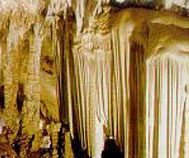 At first glance, Beijing's southwest suburban Fangshan District seems to be full of sleepy towns, ranges of barren high mountains and dozing farmers.
At first glance, Beijing's southwest suburban Fangshan District seems to be full of sleepy towns, ranges of barren high mountains and dozing farmers.
But once you shake the sleep out of your eyes, you will find it bursting with history and surprisingly cool things to do. Cultural relics like ancient monasteries, ancient city relics, including Peking Man and the Western Qing Tombs can be all found here.
You'll find some, often overlooked breathtaking, limestone caves.
Less than an hour's drive west of downtown Beijing, Shihuadong (Stone-Flower Cave), Yinhudong (Silver Fox Cave) and Xianqidong (Xianqi Cave) are the three largest limestone channels in Beijing's west mountainous areas.
Shihua Caves
Located in Nancheying village, Fangshan District, 55 km away from the city centre, Shihua cave is an eight-storey water-eroded cave with a drop of 130 metres.
Now the first four storeys are open to tourists.
Beijing Shihua Cave, Guilin Ludi Cave, Fujian Yuhu Cave and Hangzhou Yaolin Cave are the four most famous karst caves in China.
There are 20 scenic spots with around 150 points of interest in Shihua Cave. Stalactites and stalagmites of various fantastic shapes give a mystical appearance. In addition to natural scenery, there are also exhibitions of rare animals and pictures of other world-famous caves. The Zoo of Rare Animals and City of Emperor Qin Shihuang's Buried Sculpture Legion are also found here.
Many restaurants and market places sell local foods and products.
The temperature in the cave is around 13 C, making it accessible all year round.
Admission: 35 yuan (US$4.20) for the first two storeys; 70 yuan (US$8.40) for all four.
Tansportation: Take tour bus 7 at Qianmen or Fuchengmen.
Yinhu Caves
This is another limestone cave, opened to the public in 1999.
Located in the valley at Xiayinshui Village, the entrance was originally for coal mining.
The natural cave is below the middle of the mining tunnel, with a length of about 5 km.
There are two branches in the cave. The east branch has been developed for tourism. The west branch, with a low relief, has a subterranean stream where the alluvial deposits are abundant.
Yinhu Cave is immense, with limpid water and beautiful chemical deposits. The needle crystal clusters on a stalagmite are spotlessly white and look like a silver fox, giving the cave its name.
If you want to look at the corners of the caves clearly, take a flashlight. It is advisable to go with friends to minimize the chances of getting lost in the labyrinth-like caves.
Admission: 26 yuan (US$3) for cave and 15 yuan (US$1.80) for underground river boating.
Transportation: Take bus 917 from Tianqiao, Xuanwu District, or 326 from Pingguoyuan.
Tel: 010-8037-7936.
Xianqi Caves
Located in Shidu Scenic Spot (10 Ferries), in the southwest of Fangshan District, about 60 kilometres away from the western downtown area.
The Shidu Scenic Spot has special karst landforms with the largest area of limestones, karst mountains and gullies in North China.
Visitors can enjoy stalactites, cobbles, stone curtains, pillars and flowers inside the cave, a real eye-opening experience.
Take bus 917 from Tianqiao, Xuanwu District.
Admission: 20 yuan (US$2.40) for the cave.
Tel: 010-6134-9240.
(Beijing Weekend March 13, 2003)
|

